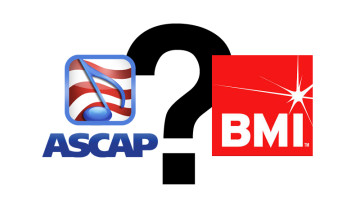ASCAP and BMI are the major performance rights organizations in the US. They collect the songwriter’s share of royalties for performances of songs on broadcast mediums like radio and television, and public performances such as songs played in clubs, department stores, and music venues. Nobody at either company could tell you the exact formula they use to pay rights holders. Unless you’re getting a lot of air time, you won’t be seeing a dime. Nonetheless, it’s useful to register with a PRO as a badge of professional musician honor, and it sets you up to receive royalty payments in the event one of your songs does achieve heavy rotation. There are some perks associated with either PRO that might prove occasionally useful.
All things considered, either PRO will suffice, but Songhack recommends ASCAP over BMI to independent musicians for the following reasons:
Hacking the PRO Choice
OWN YOUR OWN PUBLISHING – Whichever PRO you choose, we strongly advise you to register as both a writer and a publisher. Long story short, the writer and publisher will generally split royalties paid by the PRO 50/50. The writer’s share is always half and paid directly to the artist by the PRO, but the publisher’s share can be split up between multiple publishers. By default, the songwriter is the publisher… but you have to be registered with a PRO as a publisher to collect that half of the royalties. You can also publish your songs with other publishers, and give them 50% of the royalties, or even negotiate a split of that 50% between your publishing company and theirs. ASCAP charges $50 for writer registration, $50 for publisher registration — both are one-time fees. BMI has free writer registration, but publisher registration is a $250 one-time fee. WINNER: ASCAP
KNOW YOUR HISTORY – The abridged history of ASCAP and BMI is that ASCAP was founded by songwriters in the early 20th century, when public performance was still the primary way people listened to music. Their goal was to protect the composer’s copyright, which in part gives the writer a monopoly over making money from a song’s distribution. They filed lawsuits against companies that were using music without paying artists, lobbied for legislation to protect artists, negotiated licensing deals and set up collection mechanisms. When recordings overtook performance as the main way people listened to music — particularly, as radio gained popularity — ASCAP tried their best to get artists paid from radio play. At this point, many artists were signing their rights over to record labels. The radio broadcasters wanted to keep this money for themselves, pointing out that radio actually benefitted the labels by promoting records for sale. Eventually, the radio broadcasters formed BMI and started blacklisting ASCAP artists, forcing artists who wanted to be on radio to go with BMI. Eventually things evened out, the balance of power between ASCAP and BMI stabilized, and each became an unofficial collections arm of major labels and publishers. They continue to market and represent themselves as champions of the artist. This is true, but only to an extent, for the majority of royalties they collect go to record labels and publishers. Anyway, if we had to choose which is more artist-friendly, we’ll pick the one founded by songwriters over the one founded by broadcast corporations. WINNER: ASCAP
DIGITAL INFRASTRUCTURE – Registering with a PRO is just the first step in getting paid royalties. The songwriter(s) and publisher(s) of each song, in addition to the song title and other metadata, must be registered with your PRO in order to collect money. Each PRO has a web-based interface to help you do this. Neither is that fun to use, but BMI has clearly invested more money and/or talent in building out their client-facing web infrastructure. BMI also wins with its B2B digital infrastructure, making it increasingly easier for the broadcasters and public venues who license BMI artist music to do so, whereas ASCAP has lagged a bit behind in the digital game. Instead of building their own infrastructure, they’ve partnered with other service vendors. WINNER: BMI
PERKS – Both PROs offer health care assistance, equipment and service discounts, partnerships with digital service and product providers, travel perks, and other offers that professional musicians can take advantage of to save money and advance their careers. Visit their websites to compare, but we think it’s a wash. WINNER: TIE
Note: You may have heard of SEASAC. They are the third PRO that services U.S. songwriters and publishers. However, unlike ASCAP or BMI, SEASAC is not open to enrollment by anyone. You have to submit an application and be approved, or be invited. They only work with established artists, or artists with “ins” to the organization. As such, we’ve ignored them here, as most independent musicians are also likely to do.
PRO Choice Hacking Links
Moses Avalon – Why You Should Wait to Join a PRO
Music industry maverick Moses Avalon gives some great advice on why an unsigned or independent musician shouldn’t feel pressured to immediately shell out $100+ to join a PRO. It’s important to have realistic expectations.






















